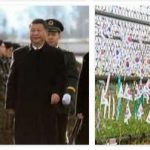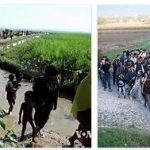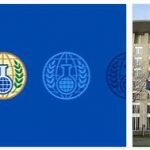In 2013, the conflict on the Korean Peninsula has intensified again. The vocabulary is extremely aggressive and the provocative actions many. Is the conflict really as threatening as it may seem at first glance?
- How is North Korea’s nuclear history?
- What are the characteristics of the conflict in Korea?
- What motives do the parties have?
- Where is the key to peace in Korea?
2: North Korea’s nuclear history
North Korea’s nuclear program dates back to the 1960s. Then the Soviets gave a research reactor to the Kim Il-sung regime. Together with Soviet training of Koreans, this was the start of a program that was increasingly run by the Koreans themselves in line with their self-sufficiency policy – the Juche ideology .
The United States placed nuclear weapons in South Korea as early as 1957. In the early 1970s, the South Koreans ran their own nuclear weapons program, but the United States pressured them to abandon it. In 1977, asked the Soviet Union North Korea ratify the Non-Proliferation Treaty (Non-Proliferation Treaty, NPT) as a condition for providing light-water reactors. The final approval came in 1985, but the reactors failed. About the same time, the South Koreans resumed their nuclear weapons program. Once again, the United States persuaded them to stop, but North Korea did not.
When the Soviet Union collapsed (1991) and China orientated itself towards the United States, South Korea and Russia, North Korea was left to itself . Trade with Russia disappeared and China’s market economy pointed in all directions other than North Korea.
Kim Il-sung therefore extended his hand to his traditional enemies – the United States, Japan and South Korea – in an attempt to resolve the conflict, develop cooperation and reduce dependence on China. International politics was changing so drastically that it seemed appropriate to take action against further Chinese steps in North Korea’s disfavor. The new North Korean policy was encouraged by the US withdrawal of nuclear weapons from South Korea in 1991.
3: 1992: The alarm goes off
In 1992 , the IAEA ( Atomic Energy Agency ) stated – through its control activities – that North Korea had recovered plutonium not only in 1990 as they claimed, but also in 1989 and 1991. The recovery yielded enough plutonium for a bomb or two. This led to a difficult and eventually dramatic diplomatic process that brought the United States and North Korea to the brink of war in 1994.
The United States then signed a framework agreement with Kim Il-sung. It did fall apart a few years later, but it was built on a template that was followed until 2012:
- North Korea was to phase out the nuclear weapons program and limit its missile program,
- Towards security guarantees, a peace agreement, normalization of relations with the United States and other countries, and financial assistance.
In 2002, the United States under George Bush jr. all ties to North Korea as they included the country in the axis of evil along with Iran and Iraq. North Korea used the diplomatic vacuum that followed to produce enough plutonium for 4-8 bombs and test a nuclear charge in 2006 . That brought the United States back to the negotiating table a few months later.
After a period of significant progress – the plutonium program was deactivated under international supervision from the United States and the IAEA – cooperation was broken again in the spring of 2009. The Security Council had convened a statement condemning a recent North Korean missile test , and sanctions were imposed on three trading companies. with rocket technology. North Korea responded by expelling both US specialists and IAEA inspectors. Then a new nuclear test followed .
4: 2012: yes to negotiations – disagreement – more tests
In February 2012, the United States and North Korea agreed to resume negotiations. North Korea agreed in advance to a temporary halt (moratorium) on testing nuclear weapons and long-range missiles and to put the new enrichment plant in Yongbyon on hold. In addition, the IAEA was to resume inspections. In return, the United States promised 240,000 tons of food aid spread over 12 months.
It happened, however, when North Korea launched a satellite at the centenary of Kim Il-sung’s birth. North Korea said it had made reservations about this while the United States claimed – rightly – that it was contrary to the preconditions, because a satellite launch has about the same military value as a test. The launch was admittedly unsuccessful and showed that North Korea is unable to supply nuclear weapons over long distances. But precisely because of this, one could expect more tests.
It happened on December 12, 2012. Then North Korea launched an Unha-3 rocket t that carried a satellite into space. The continuation was as in 2009: First, the Security Council condemned the launch and tightened the sanctions, then came a new North Korean nuclear test on 12 February 2013. Then followed another condemnation from the Security Council and notification of several new punitive measures. The timing of the North Korean nuclear tests coincided with well-known American anniversaries – Columbus Day in 2006; Memorial Day in 2009. The point is clear: North Korea wants the United States to speak.
The Americans are reluctant to reward North Korea for bad behavior, but at the same time they see that without negotiations and agreements, the problem grows. Because then the North Koreans will continue with their nuclear and missile programs. Based on their situation and way of thinking, they have no better choice. If they do not receive security guarantees on a political path, they must obtain security through nuclear deterrence.
According to HARVARDSHOES.COM, North Korea is particularly outraged by the UN reactions to the rocket launches, and feels unfairly treated . They may have a reason for that. Many countries are testing long-range missiles, and more and more are launching satellites (including Iran and South Korea) without Security Council responses . However, nuclear tests are North Korea alone. After India and Pakistan tested in 1998, no one else has done so – not even the recognized nuclear powers.









